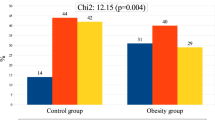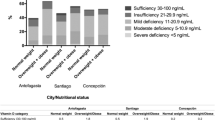Abstract
Background/Objectives:
Controversies surround the actual requirements of vitamin D in adolescents. We aimed to assess the efficacy and safety of different doses of vitamin D in high schoolchildren of Taleghan (latitude 36.5°N) near Tehran.
Subjects/Methods:
In a randomized double-blind, placebo-controlled trial, 210 subjects, aged 14–20 years, 105 boys and 105 girls were assigned to three groups; group A (n=70) received 50 000 U oral cholecalciferol monthly (equal to 1600 U per day), group B (n=70), 50 000 U bimonthly (equal to 800 U/day) and group C (n=70), placebo. The study began in November 2007 and continued until April 2008. Serum 25(OH)D, parathyroid hormone (PTH), calcium (Ca) and bone markers were measured.
Results:
At baseline, girls had significantly lower concentrations of 25(OH)D than boys (19.25±16 vs 40.5±14 nmol/l). Mean 25(OH)D increased from 32±22 to 60±27.5 and 28.25±14.5 to 45.75±24 in groups A and B, respectively (P<0.001); however, it did not change over time in group C (29±18 vs 29±17.5). Increment of mean 25(OH)D was higher in group A than in group B (P<0.01). In all groups, girls had lower concentrations of 25(OH)D than boys (P<0.001). Serum Ca increased and PTH decreased in groups A and B (P<0.001). In group A, osteocalcin (OC) and bone-specific alkaline phosphatase increased (P<0.001), but in group B only OC increased (P<0.001). Urine C telopeptide and Ca did not change in all three groups; no case of hypercalcemia was observed.
Conclusions:
Although monthly administration of 50 000 U vitamin D3 increased serum 25(OH)D significantly, it was apparently not enough to correct vitamin D deficiency especially in girls.
This is a preview of subscription content, access via your institution
Access options
Subscribe to this journal
Receive 12 print issues and online access
$259.00 per year
only $21.58 per issue
Buy this article
- Purchase on Springer Link
- Instant access to full article PDF
Prices may be subject to local taxes which are calculated during checkout


Similar content being viewed by others
References
Ainy E, Ghazi AA, Azizi F (2006). Changes in calcium, 25(OH) vitamin D3 and other biochemical factors during pregnancy. J Endocrinol Invest 29, 303–307.
Aksnes L, Aarskog D (1982). Plasma-concentrations of vitamin-D metabolites in puberty—effect of sexual-maturation and implications for growth. J Clin Endocrinol Metab 55, 94–101.
Alagol F, Shihadeh Y, Boztepe H, Tanakol R, Yarman S, Azizlerli H et al. (2000). Sunlight exposure and vitamin D deficiency in Turkish women. J Endocrinol Invest 23, 173–177.
Barger-Lux MJ, Heaney RP (2002). Effects of above average summer sun exposure on serum 25-hydroxyvitamin D and calcium absorption. J Clin Endocrinol Metab 87, 4952–4956.
Baroncelli GI, Bereket A, El Kholy M, Audi L, Cesur Y, Ozkan B et al. (2008). Rickets in the Middle East: role of environment and genetic predisposition. J Clin Endocrinol Metab 93, 1743–1750.
Baroncelli GI, Bertelloni S, Ceccarelli C, Amato V, Saggese G (2000). Bone turnover in children with vitamin D deficiency rickets before and during treatment. Acta Paediatrica 89, 513–518.
Bikle D (2009). Nonclassic Actions of Vitamin D. J Clin Endocrinol Metab 94, 26–34.
Bodnar LM, Simhan HN, Powers RW, Frank MP, Cooperstein E, Roberts JM (2007). High prevalence of vitamin D insufficiency in black and white pregnant women residing in the northern United States and their neonates. J Nutr 137, 447–452.
Cashman KD, Hill TR, Cotter AA, Boreham CA, Dubitzky W, Murray L et al. (2008). Low vitamin D status adversely affects bone health parameters in adolescents. Am J Clin Nutr 87, 1039–1044.
Cheng S, Tylavsky F, Kroger H, Karkkainen M, Lyytikainen A, Koistinen A et al. (2003). Association of low 25-hydroxyvitamin D concentrations with elevated parathyroid hormone concentrations and low cortical bone density in early pubertal and prepubertal Finnish girls. Am J Clin Nutr 78, 485–492.
Dahifar H, Faraji A, Yassobi S, Ghorbani A (2007). Asymptomatic rickets in adolescent girls. Indian J Pediatr 74, 571–575.
Du X, Greenfield H, Fraser DR, Ge K, Trube A, Wang Y (2001). Vitamin D deficiency and associated factors in adolescent girls in Beijing. Am J Clin Nutr 74, 494–500.
El-Hajj Fuleihan G, Nabulsi M, Choucair M, Salamoun M, Hajj Shahine C, Kizirian A et al. (2001). Hypovitaminosis D in healthy schoolchildren. Pediatrics 107, E53.
Ginde AA, Liu MC, Camargo CA (2009). Demographic differences and trends of vitamin D insufficiency in the US population, 1988–2004. Arc Intern Med 169, 626–632.
Gordon CM, DePeter KC, Feldman HA, Grace E, Emans SJ (2004). Prevalence of vitamin D deficiency among healthy adolescents. Arch Pediatr Adolesc Med 158, 531–537.
Guillemant J, Le HT, Maria A, Allemandou A, Peres G, Guillemant S (2001). Wintertime vitamin D deficiency in male adolescents: effect on parathyroid function and response to vitamin D3 supplements. Osteoporos Int 12, 875–879.
Hashemipour S, Larijani B, Adibi H, Javadi E, Sedaghat M, Pajouhi M et al. (2004). Vitamin D deficiency and causative factors in the population of Tehran. BMC Public Health 4, 38.
Holick MF (2004). Vitamin D: importance in the prevention of cancers, type 1 diabetes, heart disease, and osteoporosis. Am J Clin Nutr 79, 362–371.
Holick MF (2007). Vitamin D deficiency. N Engl J Med 357, 266–281.
Holick MF (2009). MrOs is D-ficient. J Clin Endocrinol Metab 94, 1092–1093.
Hollis BW (2005). Circulating 25-hydroxyvitamin D levels indicative of vitamin D sufficiency: implications for establishing a new effective dietary intake recommendation for vitamin D. J Nutr 135, 317–322.
Ilich JZ, Badenhop NE, Jelic T, Clairmont AC, Nagode LA, Matkovic V (1997). Calcitriol and bone mass accumulation in females during puberty. Calcif Tissue Int 61, 104–109.
Kimball S, Fuleihan Gel H, Vieth R (2008). Vitamin D: a growing perspective. Crit Rev Clin Lab Sci 45, 339–414.
Lehtonen-Veromaa M, Mottonen T, Irjala K, Karkkainen M, Lamberg-Allardt C, Hakola P et al. (1999). Vitamin D intake is low and hypovitaminosis D common in healthy 9- to 15-year-old Finnish girls. Eur J Clin Nutr 53, 746–751.
Maalouf J, Nabulsi M, Vieth R, Kimball S, El-Rassi R, Mahfoud Z et al. (2008). Short- and long-term safety of weekly high-dose vitamin D3 supplementation in school children. J Clin Endocrinol Metab 93, 2693–2701.
Mark S, Gray-Donald K, Delvin EE, O′Loughlin J, Paradis G, Levy E et al. (2008). Low vitamin D status in a representative sample of youth from Quebec, Canada. Clin Chem 54, 1283–1289.
Mirsaeid Ghazi AA, Rais Zadeh F, Pezeshk P, Azizi F (2004). Seasonal variation of serum 25 hydroxy D3 in residents of Tehran. J Endocrinol Invest 27, 676–679.
Nesby-O’Dell S, Scanlon KS, Cogswell ME, Gillespie C, Hollis BW, Looker AC et al. (2002). Hypovitaminosis D prevalence and determinants among African American and white women of reproductive age: third National Health and Nutrition Examination Survey, 1988–1994. Am J Clin Nutr 76, 187–192.
Oliveri B, Cassinelli H, Mautalen C, Ayala M (1996). Vitamin D prophylaxis in children with a single dose of 150 000 IU of vitamin D. Eur J Clin Nutr 50, 807–810.
Orwoll E, Nielson CM, Marshall LM, Lambert L, Holton KF, Hoffman AR et al. (2009). Vitamin D deficiency in older men. J Clin Endocrinol Metab 94, 1214–1222.
Prentice A (2008). Vitamin D deficiency: a global perspective. Nutr Rev 66, S153–S164.
Sahu M, Bhatia V, Aggarwal A, Rawat V, Saxena P, Pandey A et al. (2009). Vitamin D deficiency in rural girls and pregnant women despite abundant sunshine in northern India. Clin Endocrinol (Oxf) 70, 680–684.
Sedrani SH, Elidrissy AW, El Arabi KM (1983). Sunlight and vitamin D status in normal Saudi subjects. Am J Clin Nutr 38, 129–132.
Sedrani SH (1984). Low 25-hydroxyvitamin-D and normal serum-calcium concentrations in Saudi-Arabia—Riyadh region. Ann Nutr Metab 28, 181–185.
Sullivan SS, Rosen CJ, Halteman WA, Chen TC, Holick MF (2005). Adolescent girls in Maine are at risk for vitamin D insufficiency. J Am Diet Assoc 105, 971–974.
Tau C, Ciriani V, Scaiola E, Acuna M (2007). Twice single doses of 100 000 IU of vitamin D in winter is adequate and safe for prevention of vitamin D deficiency in healthy children from Ushuaia, Tierra Del Fuego, Argentina. J Steroid Biochem Mol Biol 103, 651–654.
Vieth R (2004). Why the optimal requirement for vitamin D-3 is probably much higher than what is officially recommended for adults. J Steroid Biochem Mol Biol 89-90, 575–579.
Vieth R, Bischoff-Ferrari H, Boucher BJ, Dawson-Hughes B, Garland CF, Heaney RP et al. (2007). The urgent need to recommend an intake of vitamin D that is effective. Am J Clin Nutr 85, 649–650.
Zeghoud F, Delaveyne R, Rehel P, Chalas J, Garabedian M, Odievre M (1995). Vitamin-D and pubertal maturation—interest and tolerance of vitamin-D supplementation during the winter. Arch Pediatr 2, 221–226.
Acknowledgements
We thank the schoolchildren and the staff for their cooperation. We also thank Dr M Barzin and Ms N Shiva for their assistance in the preparation of the paper.
Author information
Authors and Affiliations
Corresponding author
Ethics declarations
Competing interests
The authors declare no conflict of interest.
Rights and permissions
About this article
Cite this article
Ghazi, A., Hosseinpanah, F., M.Ardakani, E. et al. Effects of different doses of oral cholecalciferol on serum 25(OH)D, PTH, calcium and bone markers during fall and winter in schoolchildren. Eur J Clin Nutr 64, 1415–1422 (2010). https://doi.org/10.1038/ejcn.2010.169
Received:
Revised:
Accepted:
Published:
Issue Date:
DOI: https://doi.org/10.1038/ejcn.2010.169
Keywords
This article is cited by
-
Daily vitamin D3 in overweight and obese children and adolescents: a randomized controlled trial
European Journal of Nutrition (2021)
-
A systematic review and meta-analysis of the response of serum 25-hydroxyvitamin D concentration to vitamin D supplementation from RCTs from around the globe
European Journal of Clinical Nutrition (2019)
-
Interventions for Prevention and Control of Epidemic of Vitamin D Deficiency
The Indian Journal of Pediatrics (2019)
-
Effects of milk powder intervention on bone mineral density and indicators related to bone metabolism in Chinese adolescents
Osteoporosis International (2019)
-
Vitamin D in pediatric age: consensus of the Italian Pediatric Society and the Italian Society of Preventive and Social Pediatrics, jointly with the Italian Federation of Pediatricians
Italian Journal of Pediatrics (2018)



